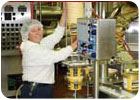
TYLER, Texas—In the Texas-Louisiana Gulf area, the Goldenbrook Farms brand is well known as the premium private label brand for Brookshire Grocery Co. Recently Brookshire's customers have found a new line of yogurt and sour cream bearing the Goldenbrook brand.
That yogurt comes from Brookshire's food manufacturing arm, SouthWest Foods. More specifically, it is made and packaged at its ice cream plant in Tyler. SouthWest Foods operates six facilities including a dairy, bakery, fresh-cut fruit, bottled water/tea and ice plant. As a member of All Star Dairy Association, SouthWest has been the recipient of numerous quality assurance awards for both its dairy and its ice cream plant.
In December 2004, the addition of a cultured product line was completed at the ice cream facility, and the company is now adding an end-of-the-line secondary packaging solution to the yogurt line.
The plant is also one of two of SouthWest's facilities that have served as a proving ground for a new technology that burns off bio-waste from the CIP systems thereby greatly reducing wastewater loads (see related story page 52). During the summer ice cream season, the ice cream plant operates around the clock to produce 100,000 gals per week.
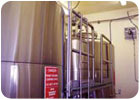
"We have yogurt at that plant now and that complements the other products very well. In our store group we maintain about 50% of the ice cream sales while going up against some well known brands, and I think we are doing well for the Brookshire Grocery Co. Of course, making these products ourselves we are able to control the quality."
Located between Dallas and Shreveport, La., the Tyler community area is home to about 175,000 people, to one annual Texas Rose Festival, and to a dairy dating back to 1929. Thirty years ago the dairy was part of the Southland Dairy Group before being sold to Morningstar Foods and, in 1990 to Brookshire's.
Founded in Tyler in 1928, Brookshire Grocery Co. currently operates more than 160 stores under the banners of Brookshire's, Super 1 Foods, ALP's, and Olé Foods in Texas, Arkansas, Louisiana and Mississippi.
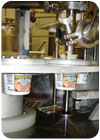
Getting yogurt right
The milk plant site was joined by an ice cream plant in January 1997. The 120,000 square foot facility has raw milk storage capacity of about 40,000 gals. The yogurt line was installed to allow Brookshire to offer a private label, premium yogurt that would compare to the regions top national brand. Ice Cream Director Hugo Fraga, said the results have exceeded expectations."It took us about a year for the research and development," Fraga said during a recent tour of the facility.
"When we decided to introduce yogurt, we said it has got to be better than or as good as the leading national brand. We used blind tasting panels through a third party, and we kept working on the product until it was preferred."
Currently the line includes 12 lowfat flavors and seven light flavors, all of them Kosher.
The installation at the ice cream plant includes a culturing room with two 2,000 gal DCI tanks.
"This room is insulated and the air is hepafiltered, and treated with UV and then kept under positive pressure," Fraga says.
After having been HTST treated, milk is pumped into one of the two tanks and inoculated with cultures. Vat set takes 16 hours before the yogurt is ready for blending.
The filling room, which gets the same air treatment, features two rotary World Cup cup fillers. This room is also kept between 35 and 38

Ice cream capabilities
The ice cream side of the operation is built around two filler lines fed by three Tetra Pak Hoyer single-barrel freezers and two Cherry Burell freezers. Together they can produce up to 3,600 gals an hour, but more often they are used intermittently or at lower speeds. The mix is prepared in two batch tanks on load cells. A mixer is used for blending. Sealright filling equipment is used to fill packages from Huhtamaki.Half gallon round containers make up the bulk of the product, and these are bundled in packs of three.
"Once the packages are filled they are oriented in bundles of three and then shrink wrapped," Fraga says. SouthWest also produces half gallon squares, pints, and 5-quart pails.
After passing through a metal detector product is sent to a spiral hardener, then eventually, it is palletized by hand and put into storage. The cold storage warehouse can handle up to 400,000 gals of ice cream.
Milk and other raw products are unloaded through a drive-through receiving bay.
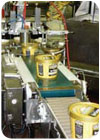
Ensuring quality
Each spring members of the All-Star Dairy Association gather in a sunny locale for the association's annual conference. In addition to educational sessions on new technologies, regulations, and business strategies, the conference includes social and family activities, golf, and tourism outings. The conference also showcases the awards portion of the association's quality assurance program. The program is a quantitative analysis of plant operations and subsequent product quality that includes plant audits and quality evaluations. The highest scoring individual dairies among the participants are recognized at the conference, and each year Southwest is among the favorites. It has received numerous awards for its dairy plant, and the ice cream plant took first place in the category four times in the last five years.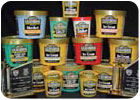
The All-Star program is just one way in which SouthWest maintains its product quality standards.
"We have a HAACP program that we implemented in 2000," Fraga says. "Standard operating procedures are used in all areas of the plant and employees are trained in good manufacturing practices."
In addition, the plant undergoes quarterly inspections and product evaluations with Randolph Associates, Inc., and Cimpro manufacturing software is used to provide lot control of ingredients, raw materials and finished products.
As with the development of the yogurt line, SouthWest has sought confirmation that its quality efforts for its ice cream products are paying off. Pitner says the proof is in the results of independent taste tests.
"We went up against a well-known Texas-based brand with our Goldenbrook Ice Cream and we beat them eight out of 10 in a blind taste test with a third party product quality organization," he says.
SouthWest manufactures 140 SKUs from the facility, these include the line of Goldenbrook Premium ice cream, a line of Hy-Top standard ice cream, and some co-packed products.
Frozen dessert product types include premium, light, no-sugar non-fat and no-sugar reduced fat, sherbet and sorbet.
The plant employs approximately 45 people in full-time and part-time positions.
Fraga, who has worked for the company for 17 years, and has been at the ice cream plant since it opened in 1997, says the staff is dedicated to producing the best possible products.
"All the people who work here are proud of what we do," he says. "And they are always working to make our ice cream and yogurt better and better."
SouthWest Foods Ice Cream Plant Vendors
ADMAGC
Barry Callebaut USA
Blue Pacific Flavors & Fragrances
Cargill
CEM
Charm Sciences
CHR Hansen
Corn Products MCP Sweeteners
DCI
HS Crocker
Danisco
David Michael
Forbes Chocolate
Fristam Pumps
Green Spot
Huhtamaki/Sealright
Kerry
McCormick and Company
Nelson Jameson
Pecan Deluxe
Poly-Pack
Safeline
Star Kay White
Terri Lynn
TIC Gums
Weber Scientific
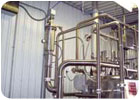
SouthWest Helps Prove Technology that Burns Organic Waste
Anyone with their ear to the ground regarding dairy plant operations has probably heard that SouthWest's v.p. of manufacturing Jim Pitner has been busy telling the story of PIOx technology the last year or so.PIOx, or Photon Initiated Oxidation, is a technology that uses Ozonation and ultraviolet light to remove chemical oxygen demand (COD) from waste water, primarily via the CIP system.
The technology was developed more than 30 years ago for the mining industry, but an application for the food industry, available for less than ten years, has been patented by Analytical Environmental Laboratories, also of Tyler, Texas. AEL's Tom Grisham leases the application to food companies.
"When Tom first came to us about it I was kind of hesitant," says Pitner. "But once I saw what it could do I became very enthusiastic about it."
That's because the technology is saving SouthWest more than $500,000 a year in combined wastewater surcharges at three of its six facilities.
The technology, as Grisham and Pitner describe it is fairly simple.
A portion of fluid is continually pulled from a CIP system or elsewhere in a system. It is treated and then re-circulated.
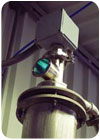
All of the mechanisms are housed in a stainless steel chamber resembling a PMO valve, that allows the introduction of air, ozone, water, and a light source.
In effect, it spreads approximately 2/5 of a gallon of solution over 74,000 square feet of surface area at a rate of 50 gallons per minute while continuously applying the light source at a distance of less than 1⁄2-inch.
SouthWest is using PIOx in a number of areas including its HTST system at its dairy, the pasteurization system at its ice cream plant, for raw milk intake and silos and for the pan washer at its bakery as well as in a lift station that captures waste from a fresh cut produce facility that's in the same building.